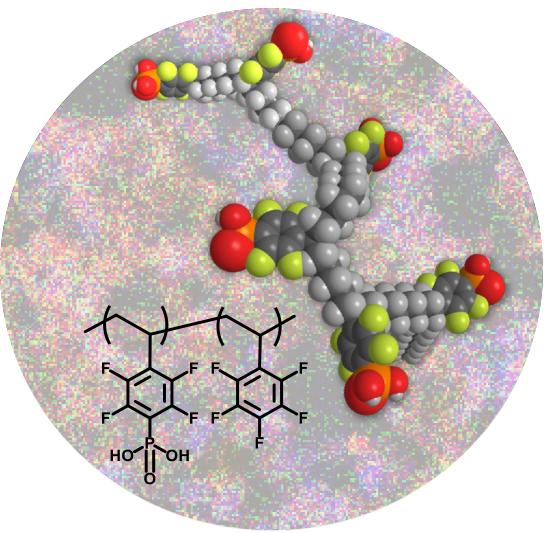Innovative proton conductor developed to be effective at high temperatures

Credit: Los Alamos National Laboratory, University of Stuttgart (Germany), University of New Mexico, and Sandia National Laboratories
LOS ALAMOS, N.M., Dec. 7, 2020– A collaborative research team, including Los Alamos National Laboratory, University of Stuttgart (Germany), University of New Mexico, and Sandia National Laboratories, has developed a proton conductor for fuel cells based on polystyrene phosphonic acids that maintain high protonic conductivity up to 200 C without water. They describe the material advance in a paper published this week in Nature Materials. Hydrogen produced from renewable, nuclear, or fossil fuels with carbon capture, utilization, and storage can help to decarbonize industries and provide environmental, energy resilience and flexibility across multiple sectors in the economy. Towards that, fuel cells are a promising technology that converts hydrogen into electricity through an electrochemical process, emitting only water.
“While the commercialization of highly efficient fuel-cell electric vehicles has successfully begun,” said Yu Seung Kim, project leader at Los Alamos, “further technological innovations are needed for the next-generation fuel cell platform evolving towards heavy-duty vehicle applications. One of the technical challenges of current fuel cells is the heat rejection from the exothermic electrochemical reactions of fuel cells.
“We had been struggling to improve the performance of high-temperature membrane fuel cells after we had developed an ion-pair coordinated membrane in 2016,” said Kim. “The ion-pair polymers are good for membrane use, but the high content of phosphoric acid dopants caused electrode poisoning and acid flooding when we used the polymer as an electrode binder.”
In current fuel cells, the heat rejection requirement is met by operating the fuel cell at a high cell voltage. To achieve an efficient fuel-cell powered engine, the operating temperature of fuel cell stacks must increase at least to the engine coolant temperature (100 C).
“We believed that phosphonated polymers would be a good alternative, but previous materials could not be implemented because of undesirable anhydride formation at fuel cell operating temperatures. So we have focused on preparing phosphonated polymers that do not undergo the anhydride formation. Kerres’ team at the University of Stuttgart was able to prepare such materials by introducing fluorine moiety into the polymer. It is exciting that we have now both membrane and ionomeric binder for high-temperature fuel cells,” said Kim.
Ten years ago, Atanasov and Kerres developed a new synthesis for a phosphonated poly(pentafluorostyrene) which consisted of the steps i) polymerization of pentafluorostyrene via radical emulsion polymerization and ii) phosphonation of this polymer by a nucleophilic phosphonation reaction. Surprisingly, this polymer showed a good proton conductivity being higher than Nafion in the temperature range >100°C, and an unexpected excellent chemical and thermal stability of >300°C.
Atanasov and Kerres shared their development with Kim at Los Alamos, whose team in turn developed high-temperature fuel cells to use with the phosphonated polymers. With the integration of membrane electrode assembly with LANL’s ion-pair coordinated membrane (Lee et al. Nature Energy, 1, 16120, 2016), the fuel cells employing the phosphonated polymer exhibited an excellent power density (1.13 W cm-2 under H2/O2 conditions with > 500 h stability at 160 C).
What’s next? “Reaching over 1 W cm-2 power density is a critical milestone that tells us this technology may successfully go to commercialization” said Kim. Currently, the technology is pursuing commercialization through the Department of Energy’s ARPA-E and the Hydrogen and Fuel Cell Technologies Office within the Energy Efficiency and Renewable Energy Office (EERE).
###
The paper: “Synergistically integrated phosphonated poly(pentafluorostyrene) for fuel cells” Nature Materials.
https:/
The funding: The research at Los Alamos was funded by the DOE ARPA-E and EERE Hydrogen and Fuel Cell Technologies Office. The work supports the Laboratory’s Energy Security mission area.
About Los Alamos National Laboratory
Los Alamos National Laboratory, a multidisciplinary research institution engaged in strategic science on behalf of national security, is managed by Triad, a public service oriented, national security science organization equally owned by its three founding members: Battelle Memorial Institute (Battelle), the Texas A&M University System (TAMUS), and the Regents of the University of California (UC) for the Department of Energy’s National Nuclear Security Administration.
Los Alamos enhances national security by ensuring the safety and reliability of the U.S. nuclear stockpile, developing technologies to reduce threats from weapons of mass destruction, and solving problems related to energy, environment, infrastructure, health, and global security concerns.
LA-UR-20-29919
Media Contact
Nancy Ambrosiano
[email protected]
Original Source
https:/
Related Journal Article
http://dx.




